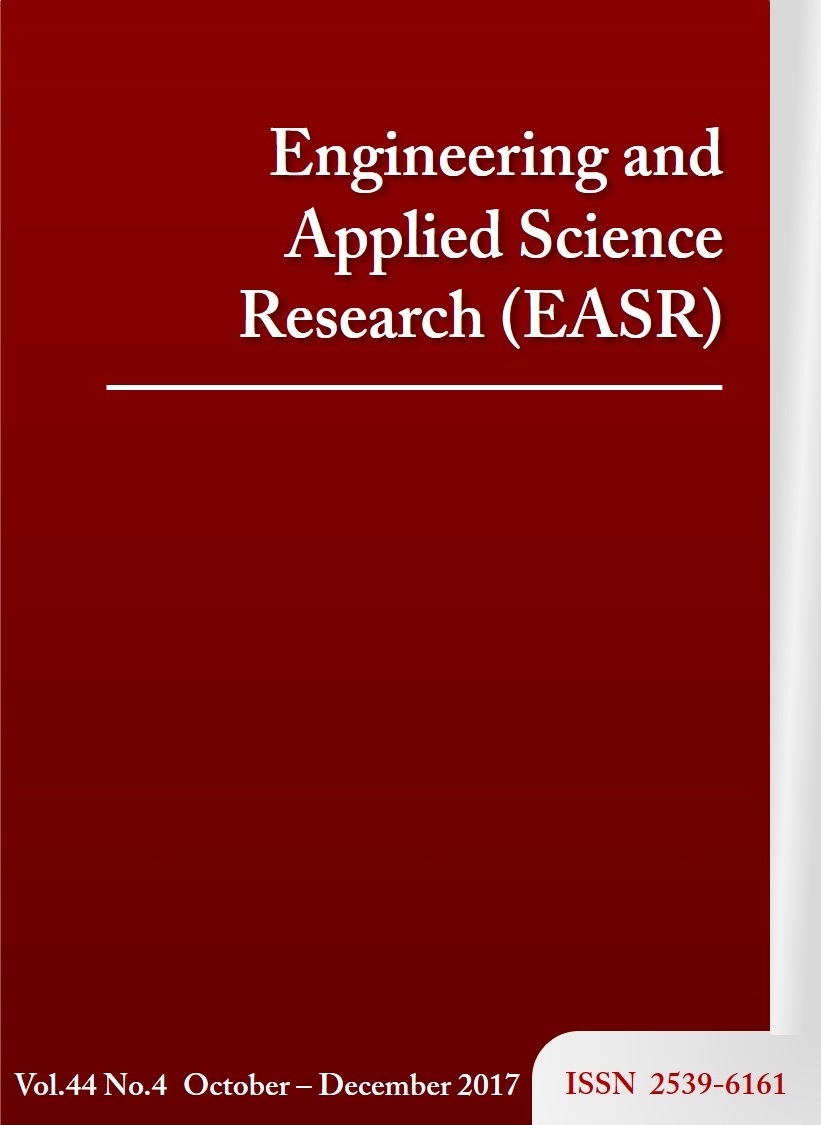Effect of oxygen on sulfur products from H2S removal by Thiobacillus in a biotrickling filter column
Main Article Content
Abstract
This study investigated a H2S removal process using Thiobacillus in a biotrickling filter column and the effect of dissolved oxygen on the sulfur products. Thiobacillus cultures were isolated from UASB mixed liquor of a fruit processing factory using Thiobacillus medium (for Thiobacillus thioparus) and Thiobacillus denitrificans medium (for Thiobacillus denitrificans). The two cultures were separately inoculated into two lab scale biotrickling filters with H2S fed at the bottom of the column and culture media trickled from the top. Due to its high solubility, 30-40% of the H2S was removed in abiotic (control) columns by dissolving into the liquid phase. More H2S and dissolved sulfide were removed in biotic columns. With H2S at 2000 ppmv, 89-93% removal was achieved by T. thioparus and 74-78% by T. denitrificans. The product from H2S removal by both cultures contained more sulfur in elemental form than in sulfate form. However, element sulfur production was affected by dissolved oxygen (DO). Production of element sulfur was highest at 1- 2 mgO/L. It decreased as DO increased. To determine the species involved in the removal process, molecular identification was conducted. It revealed that four species were common in the two columns. T. thioparus and T. denitrificans were found in both columns but each predominated in the column containing their respective culture medium.
Article Details
This work is licensed under a Creative Commons Attribution-NonCommercial-NoDerivatives 4.0 International License.
References
[2] Kantachote D, Innuwat W. Isolation of Thiobacillus sp. for use in treatment of rubber sheet wastewater. Songklanakarin J Sci Technol. 2004;26:649-57.
[3] Tchobanoglous G, Burton FL, Stensel. HD. Wastewater engineering treatment and reuse. 4th ed. New York:McGraw-Hill Companies; 2003.
[4] Weiland P. Biogas production: current state and perspectives. Appl Microbiol Biotechnol. 2010;85:849-60.
[5] Presson M, Jonsson O, Wellinger A. Biogas upgrading to vehicle fuel standards and grid injection. Aadorf, Switzerlan: IEA Bioenergy; 2006.
[6] Occupational Safety and Health Administration. Hydrogen sulfide: health effects of H2S exposure. Washington: U.S. Department of Labor; 2006.
[7] Xu Q, Townsenda T, Bittona G. Inhibition of hydrogen sulfide generation from disposed gypsum drywall using chemical inhibitors. J Hazard Mater. 2011;191:204-11.
[8] Elias A, Barona A, Arreguy A, Rios J, Aranguiz I, Peñas J. Evaluation of a packing material for the biodegradation of H2S and product analysis. Process Biochem. 2002;37:813-20.
[9] Syed M, Soreanu G, Falletta P, Béland M. Removal of hydrogen sulfide from gas streams using biological processes - a review. Can Biosyst Eng. 2006;48:1-14.
[10] Madigan MT, Martinko JM. Brock biology of microorgnisms. 14st ed. U.S.: Pearson Education; 2006.
[11] Friedrich CG, Rother D, Bardischewsky F, Quentmeier A, Fischer J. Oxidation of reduced inorganic sulfur compounds by bacteria: emergence of a common mechanism. Appl Environ Microbiol. 2001;67:2873-82.
[12] Cadenhead P, Sublette KL. Oxidation of hydrogen sulfide by Thiobacilli. Biotechnol Bioeng. 1990;35(11):1150-4.
[13] Morgan-Sagastume JM, Noyola A. Hydrogen sulfide removal by compost biofiltration: effect of mixing the filter media on operational factors. Bioresour Technol. 2006;97:1546-53.
[14] Duana H, Koea LCC, Yanb R, Chenb X. Biological treatment of H2S using pellet activated carbon as a carrier of microorganisms in a biofilter. Wat Res. 2006;40:2629-36.
[15] Kim JH, Rene ER, Park HS. Biological oxidation of hydrogen sulfide under steady and transient state conditions in an immobilized cell biofilter. Bioresour Technol. 2008;99:583-8.
[16] Ramírez M, Gómez JM, Aroca G, Cantero D. Removal of hydrogen sulfide by immobilized Thiobacillus thioparus in a biotrickling filter packed with polyurethane foam. Bioresource Technol. 2009;100:4989-95.
[17] Toth G, Nemestothy N, Belafi-Bako K, Vozik D, Bakonyi P. Degradation of hydrogen sulfide by immobilized Thiobacillus thioparus in continuous biotrickling reactor fed with synthetic gas mixture. Int Biodeter &Biodegr. 2015;105:185-91.
[18] Solciaa RB, Ramírez M, Fernández M, Canteroa D, Bevilaqua D. Hydrogen sulphide removal from air by biotrickling filter using open-pore polyurethane foam as a carrier. Biochem Eng J. 2014;84:1-8.
[19] Tomàs M, Fortuny M, Lao C, Gabriel D, Lafuente J, Gamisans X. Technical and economical study of a full-scale biotrickling filter for H2S removal from biogas. Water Pract Tech. 2009;4(2):26-33.
[20] Keyser M, Britz TJ, Witthuhn RC. Fingerprinting and identification of bacteria present in UASB granules used to treat winery, brewery, distillery or peach-lye canning wastewater. S Afr J Enol Vitic. 2007;28:69-79.
[21] APHA&AAWWA&WEF. Standard methods for the examination of water and wastewater. 22nd ed. Washington: American Public Health Association, American Water Works Association, Water Environment Federation; 2012.
[22] Atlas RM. Handbook of media for environmental microbiology. 2nd ed. USA: CRC Press; 2005.
[23] Qin H, Zhao Y, Liu H, Gao Z, Wang J, Yao B, et al. CdS thin films on LiNbO3 (104) and silicon (111) substrates prepared through an atom substitution method. J Solid State Chem. 2011;184:725-8.
[24] Ngaonee N. H2S Removal in full scale biotrickling filter with UASB effluent. Bangkok, Thailand: Kasetsart university; 2011.
[25] ASTM. Standard test method for hydrogen sulfide in liquefied petroleum (LP) gases (Lead Acetate method): D242. West Conshohocken, PA: ASTM Internationa; 2013.
[26] Doungprasopsuk W, Suwanvitaya P. Hydrogen sulfide removal by bacteria from upflow anaerobic sludge blanket. Bioinspired, Biomimetic and Nanobiomaterials. 2015;4:213-22.
[27] Sharma KR, Yuan Z. Kinetics of chemical sulfide oxidation under high dissolved oxygen levels. 6th International Conference on Sewer Processes an Networks;2010Nov 7-10; Gold Coast, Australia. London: IWA Publishing; 2010. p. 1-3.
[28] Nishimura S, Yoda M. Removal of hydrogen sulfide from an anaerobic biogas using a bio-scrubber. Water Sci Technol. 1997;36:349-56.


